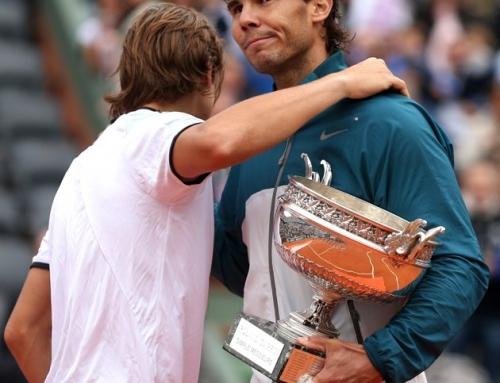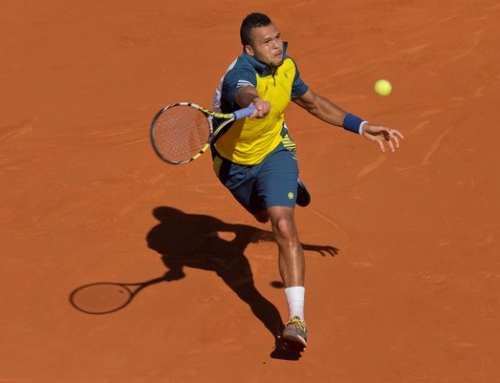 In a post-match interview, John McEnroe asked if Rafa had played his best match of the year to beat Robin Soderling. Rafa said, no, it wasn’t his best match. He thought he played better in Monte Carlo. Of course, announcers like McEnroe want answers that the best players play their best in the biggest spotlight. McEnroe doesn’t want to hear that Rafa played perfection at Umag, even if Rafa believes it to be true.
In a post-match interview, John McEnroe asked if Rafa had played his best match of the year to beat Robin Soderling. Rafa said, no, it wasn’t his best match. He thought he played better in Monte Carlo. Of course, announcers like McEnroe want answers that the best players play their best in the biggest spotlight. McEnroe doesn’t want to hear that Rafa played perfection at Umag, even if Rafa believes it to be true.
What does it mean to play the best? Presumably, it means you are beating a player that has historically given you trouble, and you are handling everything they throw at you. When you beat Fernando Verdasco, a top 10 player, love and 1, that’s domination. That’s control.
But when a player who hits as big as Soderling pounds ball after ball, and you’re doing all you can to keep the ball in play and hope he makes an error before you cough up a short ball, that’s far from ideal circumstances.
Robin Soderling will never be known as a versatile tennis player. Although many players have added diversity to their game–drop shots, slices, forays to the net–Robin Soderling has opted to do what he does (hit the ball hard) as best he can. He doesn’t mess with slices. He doesn’t come to net very much. He almost never drop shots. In an era where versatility is becoming increasingly important, Soderling bucks the trend and decides to play powerball.
Although Rafa has been developing a more aggressive posture, he apparently decided to go a bit old school against Robin, at least, old school for Rafa. Rafa is among the quickest players on tour and handles the hard struck ball almost better than anyone, including Roger Federer. For about two sets, Rafa spun balls way up high. For about a set and a half, Robin kept pounding the ball, sometimes 10-15 times in a row. Against most players, half that many shots would be needed to get winners. Robin was forced to hit 4, 5, 6 more shots than he usually does.
Initially, he seemed rusty. He got broken in the first set, but was starting to build confidence. After holding 1-0, Robin had chances to break Rafa. But it seemed each time he was ready to break, he’d overplay a shot, or Rafa would hit a good shot. He couldn’t seem to hit that one hard shot that landed in to break. That seemed to break Robin’s spirit.
If you look at the statistics, Rafa’s first serve percentage ended up at 77%, which is gaudy. In the first set, he started at a healthy 65%. This moved up to 81% in the second set. In the third set, he raised it to a sickening 87%. Meanwhile, Robin started at 57%, then went down to 44%, then came up to 66%.
The match didn’t so much turn on Robin’s breaks, though certainly that played a role. It was how effective Rafa was at holding serve. This year, Rafa won 74% of first serves, 65% of second serves. Robin won 65% of first serves and 61% of second serves, which was close to how he played last year. Rafa, however, won 66% of first serves and only 44% of second serves. Even so, Rafa also served at 77% last year, but last year, Robin was more effective at winning second serve points.
Another big difference last year was Robin’s ability to break serve. Nearly every time Rafa had a break point against him, Robin capitalized. Robin won 5 of 6 break points last year. This year, Robin had 0 breaks despite 8 break opportunities.
Had Robin broken early in the second set, he might have built confidence that his strategy was working. But since Rafa held, Robin seemed to despair, and his first serve percentage plummeted and he began to miss more. In the third set, when Rafa broke early, he seemed to believe that was enough. There was no need to get multiple breaks on Robin. He was serving well and not being seriously threatened (although Robin did get a break point).
On the one hand, some would argue that Robin didn’t change up his strategy. He doesn’t have a tremendous amount of variety in his game. Robin sliced a few short returns, and this seemed to put Rafa into a bit of trouble as he was forced to net. It’s hard to hit short and bait Rafa to net, which is where Rafa is at his weakest, and Robin didn’t pursue that strategy much. He only drop shotted one time, but it was for a winner.
Robin seemed unsure whether to approach the net. In one point, he hit a hard shot up the line, then began to head to net, then backed off. Rafa hit a crosscourt backhand out of Robin’s reach. Although one might argue that he should have kept going to net, that crosscourt backhand would have passed him anyway. Indeed, it’s really hard to attack Rafa’s backhand on an approach, because he hits the angled passing shot into the corner of the service box time and again. Most players never even get a racquet on that shot. Indeed, one wonders why a player doesn’t just cheat in that direction and dare Rafa to pass down the line (which, admittedly, he could do easily).
By the third set, Soderling was done for. He was broken, and managed to hold serve, but with Rafa serving nearly 90% on first serves, Soderling was not getting many looks to break. The long driving rallies that marked most of the first set were being replaced by much shorter rallies and earlier misses. Rafa made very few unforced errors throughout the match. One could argue that there wasn’t really a way for Rafa to make unforced errors with Soderling hitting so hard, but the fact is, Rafa got ball after ball back.
It was suggested that wet clay would have helped Robin. But the presumption was that Rafa would be unable to chase down Robin’s shots and that the slow clay would have allowed Robin to retrieve more balls. The fact of the matter was Rafa was already chasing down quite a few balls and playing insanely good defense. Wet clay may have made that easier for Rafa to retrieve shots. Robin seemed OK with hitting Rafa’s higher trajectory balls, but Rafa didn’t seem to mind that. He was willing to put up shot after shot and wait for Robin to miss.
Also, Robin’s serves, despite being 126 mph (on average) vs. Rafael’s 111 mph, wasn’t as overwhelming as it could have been. Indeed, Robin found himself trying to get out of break point situations himself. Roger Federer always says that if he serves well, i.e., he holds and faces few break points, then everything flows from there. Rafa does a good job at fast serves, and his own serve is tricky enough that players don’t seem to be able to tee off and pressure him.
Robin Soderling may have to rethink the way he plays and add more variety to his game. He’s basically put his eggs in one basket. Either he learns to be ultra-steady hitting this hard (hard to do), or he adds different parts to his game (more reasonable). Against most players, his hard-hitting style is just too much. But against a player of Nadal’s talent, at least on clay, it’s just not enough.
So Rafa reclaims number 1, and now one wonders what will happen at Wimbledon.
Roger Federer is likely to be favored at Wimbledon, but he’ll need to serve really well. Rafa will be second favorite. Beyond that, who else? Andy Roddick, perhaps. Even Robin Soderling might be good until the quarters, but who knows how losing the French will affect him. At least, he can say it wasn’t that close and that Rafa just outplayed him.
In the meanwhile, the king of clay has returned. Let the pretenders beware.




![[French Open] The tactics of the Djokovic-Nadal semifinals](https://www.essentialtennis.com/wp-content/uploads/2013/06/20130607nole-500x383.jpg)
![[French Open, SF] David Ferrer defeats Tsonga in straight sets to reach first Slam final](https://www.essentialtennis.com/wp-content/uploads/2013/06/20130607ferrer-500x383.jpg)
![[French Open, SF] Nadal escapes epic 5-setter with win over Djokovic, to compete for 8th title](https://www.essentialtennis.com/wp-content/uploads/2013/06/20130607rafa-500x383.jpg)
